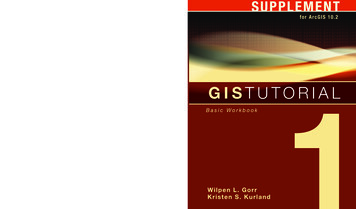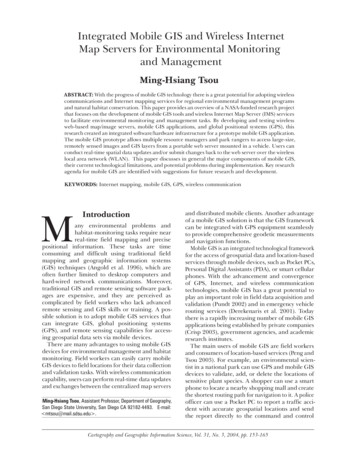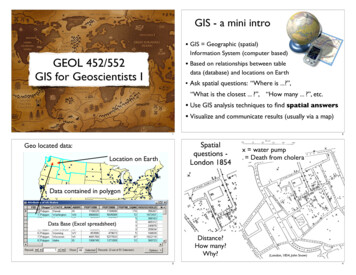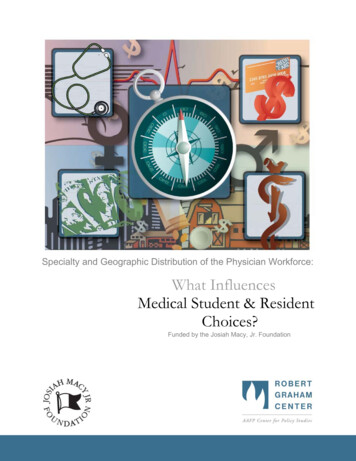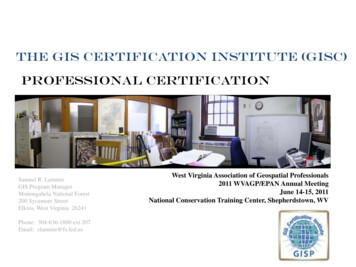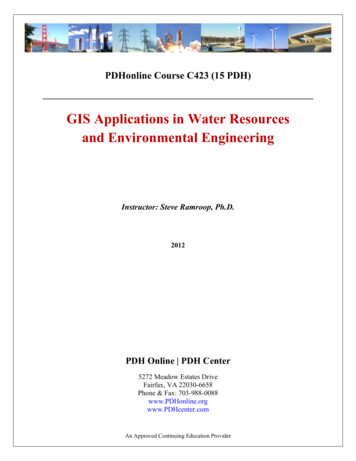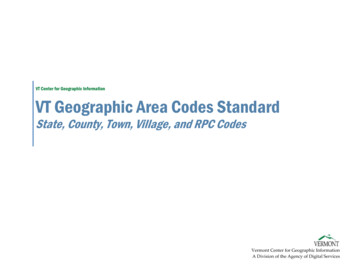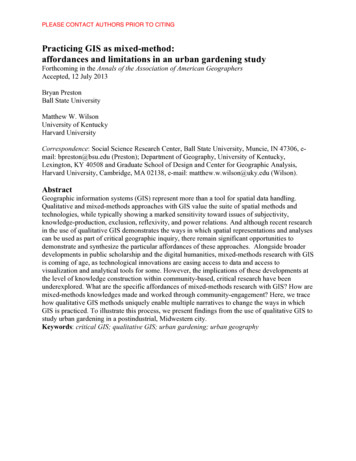
Transcription
PLEASE CONTACT AUTHORS PRIOR TO CITINGPracticing GIS as mixed-method:affordances and limitations in an urban gardening studyForthcoming in the Annals of the Association of American GeographersAccepted, 12 July 2013Bryan PrestonBall State UniversityMatthew W. WilsonUniversity of KentuckyHarvard UniversityCorrespondence: Social Science Research Center, Ball State University, Muncie, IN 47306, email: bpreston@bsu.edu (Preston); Department of Geography, University of Kentucky,Lexington, KY 40508 and Graduate School of Design and Center for Geographic Analysis,Harvard University, Cambridge, MA 02138, e-mail: matthew.w.wilson@uky.edu (Wilson).AbstractGeographic information systems (GIS) represent more than a tool for spatial data handling.Qualitative and mixed-methods approaches with GIS value the suite of spatial methods andtechnologies, while typically showing a marked sensitivity toward issues of subjectivity,knowledge-production, exclusion, reflexivity, and power relations. And although recent researchin the use of qualitative GIS demonstrates the ways in which spatial representations and analysescan be used as part of critical geographic inquiry, there remain significant opportunities todemonstrate and synthesize the particular affordances of these approaches. Alongside broaderdevelopments in public scholarship and the digital humanities, mixed-methods research with GISis coming of age, as technological innovations are easing access to data and access tovisualization and analytical tools for some. However, the implications of these developments atthe level of knowledge construction within community-based, critical research have beenunderexplored. What are the specific affordances of mixed-methods research with GIS? How aremixed-methods knowledges made and worked through community-engagement? Here, we tracehow qualitative GIS methods uniquely enable multiple narratives to change the ways in whichGIS is practiced. To illustrate this process, we present findings from the use of qualitative GIS tostudy urban gardening in a postindustrial, Midwestern city.Keywords: critical GIS; qualitative GIS; urban gardening; urban geography
PLEASE CONTACT AUTHORS PRIOR TO CITINGA regional study must be done by a geographer who calls the region home. It isimpossible to understand the neighborhood without being a neighbor [T]hegeographer gets a piece of the neighborhood, but then the neighborhood gets apiece of the geographer. (Bunge 1971, xxx)The question was never to get away from facts but closer to them, not fightingempiricism but, on the contrary, renewing empiricism. (Latour 2004, 231,emphasis his)IntroductionPractice has become a central concept in critical human geography, with an emphasis on theprocesses that make up the everyday. Both macro and micro practices and habits have beentopics of exploration and have required new and renewed methods of engagement andinvolvement, further blurring the line between the researched and the researcher. Indeed, the riseof practice in Geography has demanded reconsiderations of relationality in research; as Bunge(1971, xxx) writes in the above epigraph, “it is impossible to understand the neighborhoodwithout being a neighbor”. Extended further, some in science studies have underlined this modeof engagement, as Latour writes, to reconfigure our practices of empiricism by getting “closer”to facts (see also the “mangle of practice” by Pickering 1995). In this sense, practice is both anobject and a mode of study.More specifically, geographers have also brought attention to the practices of mapping, tothink the map as simultaneously method and practice (Kitchin 2008; Cope and Elwood 2009).By understanding GIS as a set of technologies that make up these mapping practices,geographers have better understood the social implications of its use and have actively imaginednew utilizations toward critical research agendas. Practicing GIS, then, beyond treatinggeospatial technologies as merely tools, engages with the multiple contingencies that enactspatial knowledges. In other words, GIS are both a method and a methodology, a mangling ofbeing and learning that is in as well as of the world. GIS, then, is not simply shorthand for aspecific desktop computer software (produced by Esri), but, as we understand it in this research,is rapidly expanding, to include a range of techniques and technologies. Indeed, as wedemonstrate below, this expansion is also conceptual, paralleling a take-up of GIS by the criticalsocial sciences and humanities.The practice of qualitative GIS for a quintessentially spatial and socially complex topicsuch as urban gardening engages with the social implications as well as historical contingenciesof this spatial activity. A qualitative GIS can be used to visualize the spatial patterns andcorrelations between features, much like more traditional GIS, but can also include individual,perhaps marginalized, voices in the process of research. Such a set of research strategies allowsmany interpretations of several forms of knowledge and voices, embedded as both narratives andvisualizations, official and vernacular. To pursue inquiry on these themes, more conventionalGIS might have difficulty engaging with narratives and integrating participant insight,photographs and historical research with quantified phenomena and spatial analytic methods.However, a largely ethnographic-interpretative approach might not engage narrative “data” tocreate easily transmittable, and appropriately re-adaptable, spatial visualizations. Here, we enrolland reflect upon the use of qualitative GIS as a synthesis of these two approaches. We consider2
PLEASE CONTACT AUTHORS PRIOR TO CITINGurban gardening as a sort of synthesis as well: an embedded social practice sitting right at theintersection of our urban landscape, property system, social and class structure, and diets.We argue that the multi-channeled, iterative character of qualitative GIS allows for moreinclusive data collection and analyses. Diverse forms of knowledge are produced, yet the focus isless on a product – a map, an output, an answer to a spatial problem – and more on the process ofthe research itself. While we recognize that even the formations of subject positions (such asactivists) are a potential “product” of this knowledge work (McLafferty 2002), we contend thatqualitative GIS practice asks questions and pursues lines of inquiry that resist simpleconclusions. We also employ an expanded understanding of GIS, to include a spectrum ofgeospatial technologies, like web-based mapping applications. More broadly, we consider GIS asthe organizing principle of this research project itself. Admittedly, we are taking liberties withmore conventional usages of the term, but we do so in order to draw attention to the increasingmeaninglessness of considering GIS only as research tools when in fact the practice of GIS is asocial process that includes an increasing array of methods and epistemological diversity.We situate these claims within the context of research on urban gardening in aMidwestern city, elaborating the affordances1 of engaging qualitative GIS as a practice as well asa practicable research approach. In the course of this discussion, we also briefly discuss the“products” of this inquiry by touching upon three emergent themes within the research itself:gardens as sites of inter-scalar relationships connecting everyday social practice (gardening) withbroad military and economic forces, as places where gardeners and others enact their discoursesabout neighborhood revitalization, and as places where gardeners convey their personalnarratives regarding family and neighborhood communal relations. We further discuss somelimitations to this approach, sketching the pitfalls of such a flexible, exploratory, and openmethodology.On mixing methodsGIScience methods are currently experiencing an uptake by those who practice critical humangeographic research, with increasing relevance within communities of practice aroundparticipatory action research, public scholarship, and the digital, spatial humanities. And whilethe term “mixed-methods” does not necessarily represent new methodological grounds ingeographic scholarship, the application of GIS to traditionally critical human geography arenasis relatively under-examined. No doubt, critical GIS scholars, and the GIS and Society agendamore generally, have deliberated over this possibility, as a rewiring of GIS (Sieber 2004) or asGIS2 (Sheppard et al. 1999), assuming a reworking of the software itself. GIScientists have, to alimited extent, designed new forms of Internet-based GIS (Nyerges et al. 2006) and GIS-basedqualitative coding systems (Jung 2009). Additionally, the advent of web-based APIs (applicationprogramming interfaces), have enabled a wave of map mashups and Internet GIS that havefurthered a range of digital mapping activities (Miller 2006; Crampton 2009; Elwood 2009).These developments have raised the profile of digital mapping technologies, enabling their use inparticipatory action research, in public scholarship more generally, and, more recently, in thedigital humanities. These developments, as well as those in other related fields, have contributedto a rising interest in the methodology of mixed-methods.Participatory action research (PAR) is a method that problematizes the conventionaldistinction between researchers and the researched as a way to create positive change for thecommunity involved (Kindon et al. 2007). In PAR, the problem, issue, and/or research questionemerges from the co-participants in the research. Within such an approach, the method engaged3
PLEASE CONTACT AUTHORS PRIOR TO CITINGin by the co-participants might be video production or performance (Garrett 2011), focus groupsor interviews (Longhurst 1996), or GIS (Elwood 2006). Therefore, mixed-methods are a certainreality of the day-to-day engagements of PAR. PAR encourages the iteration of action andreflection, where each phase of interactivity produces new knowledge and addresses newchallenges of applying scholarly research agendas to community concerns.Relatedly, a growing emphasis on the importance of public scholarship has meant moreopportunities for scholars to experiment with different modes of inquiry and a heightenedattention to methodology, or the various ways in which methods do work for scholars as well asimpacted communities. Mitchell (2008, 2) writes, “what creates a public scholar is related to aprofound urge to participate and intervene in the political practices of the world,” bringing aboutquestions of what it means to participate and to intervene. Public scholarship is therefore notlimited to the translation of scholarship into public discourse, but is about making scholarship dowork for those impacted by the studies. Different disciplines constitute this sentiment in differentways: consider public sociology (Burawoy 2004) and public geography (Fuller 2008). Fullernotes that public-oriented geographies have been around since the “so-called revolutions of‘social responsibility’ and ‘relevance’” in the early 1970s (2008, 4; see also Staeheli andMitchell 2005). Contemporary public geographies are a change in direction in both form andsubstance – recognizing, as Fuller notes, that “how to do” geography is as important as whatthose geographies are about. Indeed, there is a general attitude that Geography needs to continueto engage issues that affect the public in an accessible discourse (for instance, see the SyracuseCommunity Geography program).Digital technologies have provided one way in which the humanities have more recentlysought to bring about this kind of engagement. Recognizing that the traditional products of thehumanities are limited by their mode of delivery, humanities computing sought to digitize theartifacts and objects of humanistic inquiry to render them more accessible. Enabling questionsabout the affordances of these transformations towards digital objects, the digital humanitieshave sought to elevate the contemporary importance of “the digital” around issues ofstandardization, collaboration, and materiality (Rieger 2010; Bono et al. 2012). These issueshighlight the making of digital objects as opportunities to broaden notions of authorship andintervention. Furthermore, the spatial humanities considers the use of geographic informationtechnologies in digital humanistic inquiry (Bodenhamer et al. 2010).The qualitative GIS approach that we exercise is a mixed-methods approach, rather than amulti-methods approach. The distinction lays in the relationship between data collectionchannels. Here we follow closely Elwood’s and Cope’s (2009) differentiation between mixedand multi-methods projects. Mixed approaches “weave together diverse research techniques tofill gaps, add context, envision multiples truths, play different sources of data off each other, andprovide a sense of both the general and the particular” (5), while a multi-methods approachemploys parallel, operationally independent research strategies. In our mixed approach, data“interact” during the process of research, guiding the multiple pathways toward addressing theresearch priorities. The urban gardening research project discussed in this article provides a wayto illustrate this mixed-methods, qualitative GIS approach, though our intent is not to present itas a reproducible model even if such a reproduction were possible. Rather, our contribution hereserves as a grounded way to explain the affordances and limitations of a mixed-methods,qualitative GIS approach as well as a stage to discuss more broadly the role of mixed-methodsapproaches in spatial research, to reflect upon what it means to engage with mappingtechnologies in critical inquiry.4
PLEASE CONTACT AUTHORS PRIOR TO CITINGA Brief History of Qualitative GISThe subfield of qualitative GIS has emerged out of a series of responses and reactions to theincreased importance of GIS in academic geography and society at large, in a tradition of critiquesince the late 1980s. Responding to Openshaw’s unrestrained fervor for GIS as the “glue” tounite all of the fractures within geography because of its “explicitly naked geographicalness”(1991, 622), early critics of GIS saw it as a weapon of Empire and a powerful tool for corporatepower (Smith 1992; Rundstrom 1995; Goss 1995). Rundstrom (1995) considered that GIS is“potentially toxic to human diversity, notably the diversity of systems for knowing about theworld” (45). Goss (1995) saw geodemographic applications of GIS as employing a troubling“instrumental rationality” (171) that constitutes the infrastructure for state and private panopticsurveillance of the citizenry. Neil Smith (1992) criticized GIS as a battlefield technology, anddismissively chided the GIS community that the “time is ripe for a critical and contextual historyof GIS beyond existing internalist treatments” (258).Indeed, just behind the increased sophistication of GIS technologies in the geospatialsciences in the 1990s emerged a critical scholarship on GIS. This approach considers GIS as notsimply a data management and spatial visualization tool, but focuses on the social implicationsof GIS, reflecting on how and why researchers and planners employ GIS (Pickles 1995; also seeSheppard 1995; Pickles 1997). From GIS and Society writing informed by social theory grew theproject of “critical GIS,” which specifically examines the role that GIS plays in creatinggeographic knowledge and the ways in which broader social structures enroll this knowledge(Schuurman 2000). To GIS and Society and critical GIS scholars, the conventional treatments ofGIS research within public life as well as within the academy has tilted the use of GIS towardpositivist epistemologies (Miller 1995), an “instrumental logic” (Sheppard 1995, 5), andinternalist ethical frameworks (Crampton 1995), thereby lending support to the dominant powerstructure.According to Wilson (2009), the emergence of qualitative GIS is indicative of aproblematic in the GIS and Society debates regarding how best to approach critique andreformulation of conventional GIS practice. Earlier articulations of critical GIS raised theimportance of critique from an “insider” perspective, mastering the conventions and developingcritical and methodological innovations all within the language of the system (Schuurman 2000).Socio-behavioral studies of GIS use might fit well within such an insider’s perspective (forexample, Nyerges et al. 2002) as might the use of GIS for critical human geographic research(Pavlovskaya 2004). However, science and technology studies and ethno(carto)graphies of GISare couched in social theory and discussions regarding the role of GIS in “broader narratives ofglobal capital, institutional networks, and information sciences” (Wilson 2009, 161) andtherefore move in literatures beyond those that take up the specific language of the system itself.From this insider/outsider binary emerged qualitative GIS as a kind of synthesis.Qualitative GIS grew from the “reconstructed” (Harvey et al. 2005), critically-informedengagements with GIS to address the earlier critiques of the technology. While attuned to socialtheory and informed by feminist geographers’ notions of embodiment, situated practice, andpositionality (Kwan 2002), qualitative GIS preserves much of the language and repositions manyof the practices of conventional GIS methodology.Generally, we recognize two directions in qualitative GIS approaches: (1) the technicalintegration of qualitative materials and (2) the conceptual reworking of different epistemologies.The first approach, exemplified best by Jung (2007, 2009), envisions qualitative GIS as a5
PLEASE CONTACT AUTHORS PRIOR TO CITINGsolution to the technical problem of how to embed qualitative media such as pictures, audio andvideo into a familiar GIS software framework. Jung has forged CAQ-GIS (computer-aidedqualitative GIS) to address the needs of multimedia integration into geovisual data. RelatedlyKwan and Ding (2008) developed an approach to conduct narrative analysis within a GIS, whatthey have termed “geo-narrative.”The other direction of qualitative GIS research forces an epistemological examination ofGIS or spatial research more broadly (see Elwood and Cope 2009; Wilson 2009; Pavlovskaya2009; McLafferty 2002 and Kwan 2007 among others). This approach situates qualitative GIS,like any other methodology, as a site of a particular kind of knowledge production. Therefore,the knowledge production that happens through qualitative GIS enables a kind of messiness inexploratory research as well as potentially activates more-than-representational affects. IndeedKwan (2007) even uses GIS software as a platform to create visual art, images that expressemotion, while withholding any discernible spatial representation. Our concern is less withreworking geospatial technologies in order to accommodate qualitative methods and more withresituating qualitative GIS practice increasingly broadly: as a conceptual configuration ofresearch strategies.Garden (Variety) Geographies and GISThe transdisciplinary, yet balkanized, garden studies literature has identified the multivariateroles that gardens play in human experience: as producers of important aspects of nationalidentity (Helphand 2003), reproducers of important cultural practices in immigrant communities(Airriess and Clawson 1994), contested neighborhood spaces (Schmelzkopf 1995), places wheregrassroots and state-run service bureaucracies conflict (Jamison 1985), and spaces that fostercivic participation (Baker 2004; Shinew et al. 2004) and urban ecological restoration (Irvine1999). Crouch (2009) considers community gardening as an example of a “quietly emergent”practice of “mundane” creativity (140), while Milbourne (2009) argues that such ordinarycreativities can contribute to the “regeneration” of economically depressed neighborhoods (141).By contrast, Guthman (2008a) argues that alternative food networks in the United States,including urban gardening projects, often enhance or create spaces of white privilege that “reflecta delimited politics of the possible” (437).Smith and Kurtz (2003) consider New York’s community gardens as sites of resistance tothe neoliberalization pressures of the Giuliani administration, while others argue that in othercases neoliberal forces can enlist organized urban gardening projects to promote individualisticnotions of food procurement, protect property values and business concerns (Pudup 2008;Guthman 2008b). Recent research on community gardening in Berlin contends that city leadersenact and reinforce a neoliberal discourse while promoting community gardening projects (Rosol2012).Knigge (2006) diagrams the political economy of community gardening as a functionalelement in the cycle of urban neighborhood development and disinvestment. Community gardensnot only help groom a neighborhood for capital reinvestment through beautification, but theyalso transfer responsibilities of abandoned property maintenance from the municipal governmentto neighborhood volunteers (23). But, like Smith and Kurtz (2003), Knigge also points out thatcommunity gardens can also be sites of socialization and organization against neoliberal urbanrenewal/decay (37). Similarly, for Blomley (2004) public gardening projects are not necessarilyjust reproducers of or resistances against neoliberal practices, but are excellent sites throughwhich to critically examine the slippery notions of property and the neoliberalization of public6
PLEASE CONTACT AUTHORS PRIOR TO CITINGspace. With important exceptions, there are few studies that incorporate GIS work into suchinvestigations of urban gardening.Knigge and Cope (2006) provide a cogent example of a qualitative GIS approach thatemploys both quantitative and qualitative data, with a case study focused on the topic of thecommunity gardens of Buffalo, New York. Integrating city spatial data on neighborhoods andcommunity gardening with personal interviews, participant observation, field notes, photographs,and mapping, their work provides an example of a field study that aims to eliminate theboundaries between quantitative and qualitative GIS. The broad mixed-methods approach, whichincluded GIS, practiced by Knigge (2006) in her dissertation drew out diverse forms ofknowledge at multiple scales, which allowed examination of the contradictory roles ofcommunity gardens in the political economic context of Buffalo. A mixed-methods approachwas crucial to arriving at such findings. A similar set of questions answered using primarily oneor another investigative method would have yielded little understanding of the contradictions ofcommunity gardening practice. While the foundations of GIS centered around quantitative dataand spatial analytic functions, qualitative GIS methodologies represent a turn toward moreinclusive types of data and knowledge, an embedded reflexivity, greater attention toward powerstructures and processes of exclusion, and perhaps less tidy conclusions. And, while beyond thescope of this manuscript, new spatial media, such as location-based services and web-based mapmashups, enable further integration and juxtaposition of qualitative materials.We have sought a more focused interrogation of the affordances and limitations ofqualitative GIS, as method and practice. Here, we argue that qualitative GIS enable an iterative,intermingling of data collection and analysis, in which the concept of “data” is exploded toinclude the narrative, the visual, and the quantitative. In what follows we are lead by thefollowing two questions: (1) How does one actually practice qualitative GIS, given the emerging“game-changing,” map 2.0 technologies of recent fascination captured by neogeography,volunteered geographic information, and the geoweb more generally? and (2) How mightqualitative GIS productively extend the technical integration of qualitative materials (Jung 2007,2009; Kwan and Ding 2008) toward a discussion of the possible reconfiguration of conceptualframeworks? As a mixed-methods approach, we look to examine the epistemological affordancesof the integration of qualitative materials (such as videos, images, and interviews) as they cause areconceptualization of the underlying frameworks that typically guide conventional GIScience.Observation, analysis, and representation are configured into channels as part of a broadenedresearch strategy.Mapping MiddletownTo draw out the affordances and limitations of qualitative GIS as an approach, we begin bysituating the places and spaces to be mapped. The well-documented history of Muncie, Indianahas followed the familiar pattern of development of many other mid-sized Midwestern cities.White Euro-American settlement began in the 1820s, displacing an Algonquin communitypreviously displaced from New York. The land was divided into townships and sections via thePublic Land Survey System (Ellis 1898). As a result of uncovered natural gas reserves, the late1800s saw the region quickly transform from a collection of homesteads to a regional industrialcenter. Most historical accounts portray the gas reserves as completely squandered by the turn ofthe century, but the foundation for heavy production in the area was set (Glass and Kohrman2005). The gas boom lured the Ball Brothers Glass Manufacturing Company to build a factory7
PLEASE CONTACT AUTHORS PRIOR TO CITINGand corporate headquarters in Muncie in the late 1880s, a move that would in large part direct thefuture economic and political development of Muncie (Lynd and Lynd 1937; Carlson 2000).By the time Helen and Robert Lynd began what would become their classic sociologicalstudy of Muncie in the 1920s, heavy industrial concerns had transformed the economic andsocial fabric of the town (Lynd and Lynd 1929). It was the character of this transformation ofeveryday life that they sought to chronicle in Middletown (1929). Major employers such asBorgWarner, Chevy, General Motors, in addition to the Ball Corporation, provided the basis foremployment in Muncie for most of the 20th century. The Ball Corporation and its foundingfamily initiated a legacy that has had incalculable influence on the development of Muncie intothe present day by establishing or directing many of the major institutions of the city. The Ballpresence is manifest today in Ball State University and Ball Memorial Hospital, currently thetwo largest employers in the county by a wide margin. The 2010 census puts Muncie’spopulation at 70,085, but the population has generally declined since 1980. Such an industrialpast and present day demographics place Muncie squarely within the “rust belt” of the publicimagination (e.g. Stern and Smith 2009).A comparison between the Lynds’ class-based map of “Middletown” (Figure 12) and acurrent census map of income (Figure 2) and race (Figure 3) show the persistence of the spatialinequalities in Muncie. The White River marks the boundary of the strongest disparities in townin terms of employment and educational attainment as well as the socioeconomic measures. Onthe north side: Ball State University and the neighborhoods of its middle and upper incomeemployees, student housing, a local cultural center (Minnetrista), and the major mall and chainstore sprawl district. South of the river: downtown Muncie occupied by local businesses, lawoffices, social service agencies, and municipal government buildings, while beyond downtownlies middle-to-lower income households formerly dependent on manufacturing jobs andabandoned housing and factory spaces. Railroad tracks act as secondary borders, drawingneighborhood boundaries, separating the historic neighborhoods and downtown Muncie from themore traditionally blue collar neighborhoods to the south. It is in these latter neighborhoods,literally “south of the tracks,” that constitutes the study area (Figure 4) where qualitative GISwas used to better understand gardening activity.We practiced qualitative GIS as a series of research channels, some of which are moreeasily represented and analyzed using the traditional tools associated with GIS, while otherstriangulate and assist in interpreting the mapping of Middletown. And while the broadermethodological question that we explore in this article is around the affordances and limitationsof studying urban gardening with qualitative GIS, the actual use of qualitative GIS in Munciewas motivated by the following research questions: Where do people have gardens? How do theyarticulate why they garden? What do they do with the products of their gardens? What roles havegardens played in Muncie historically? In what ways have gardens been implicated in broaderpolitical-economic forces at play from the local to global scales? In what follows we outline thefive channels of data collection: ground survey of the study area, interviews, visual materials,historical/archival materials, and participant observation (Figure 5). In sum, we argue, theseresearch strategies compose a qualitative GIS approach. Implemented iteratively and in concert,the work from the ground survey influences the kinds of discussions held in interviews, while theproduction of visual materials draws upon and rubs against materials from the archive. Thismixed-method approach provides a front-row seat to these channels as they unfold and revealnew forms of knowledge.8
PLEASE CONTACT AUTHORS PRIOR TO CITINGGround Survey: The study area was surveyed on bicycle by conducting a visualinspection of yards. For the purposes of this survey an edible garden was defined in context onthe basis of the researcher’s emphasis on practice over Euclidean spatial configurations. Doesthe space appear to show that there is gardening occurring here? Field maps were condensed intoa Google mashup that showed the distribution of gardens in the study area (Figure 6). Someversions of these in-progr
demonstrate below, this expansion is also conceptual, paralleling a take-up of GIS by the critical social sciences and humanities. The practice of qualitative GIS for a quintessentially spatial and socially complex topic such as urban gardening engages with the social implications as well as historical contingencies of this spatial activity.
